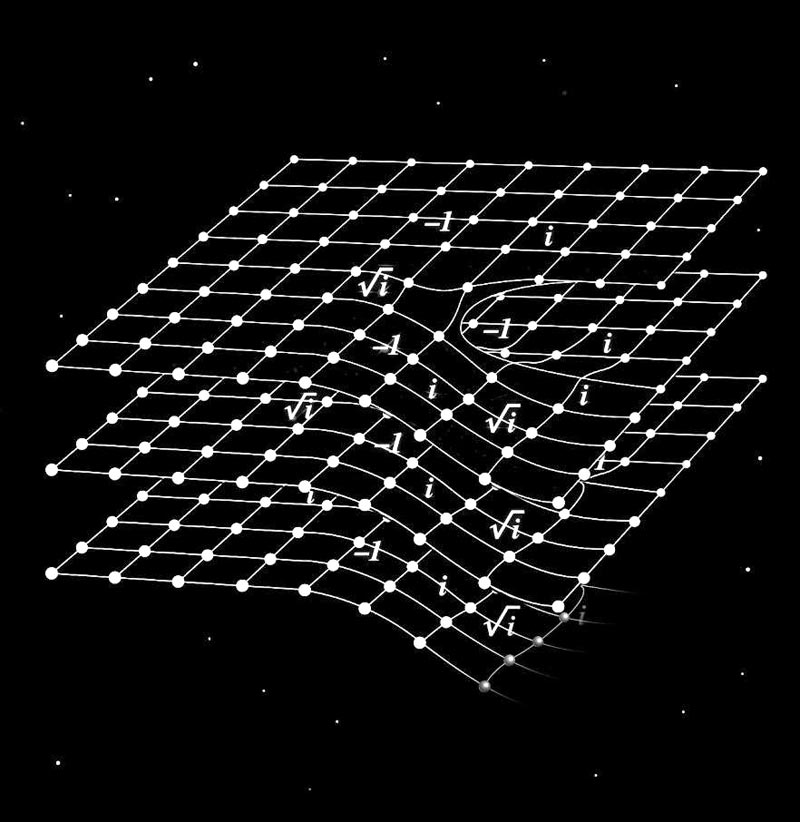

Artistic impression of a space-time twist in a crystal.
Credit: Oxford University
Intriguingly, the crux of this question may be hiding in an exotic quantum phenomenon which shows up in metals as a response to twists of space-time geometry.
A recurring theme in science fiction, most famously popularised by the “Matrix' film trilogy, is whether our physical reality is a computer simulation. While this seems to be a rather philosophical idea, in theoretical physics it has an interesting twist when applied to computer simulations of complex quantum systems.
How can one even attempt to give an answer to this question? In new research published in Science Advances magazine, a team of theoretical physicists from the University of Oxford and the Hebrew University, may have found a way to approach this answer.
While trying to address a computer simulation of a quantum phenomenon occurring in metals, the researchers, Zohar Ringel and Dmitry Kovrizhin, found proof that such a simulation is impossible as a matter of principle. More precisely, they showed how the complexity of this simulation, – that can be measured in a number of processor hours, memory size, and electricity bills, – increases in line with the number of particles one would have to simulate.
If the amount of computational resources required for a quantum simulation increases slowly (e.g. linearly) with the number of particles in the system, then one has to double a number of processors, memory, etc. in order to be able to simulate a system twice as large in the same amount of time.
But if the growth is exponential, or in other words if for every extra particle one has to double the number of processors, memory, etc., then this task becomes intractable. Note, that even just to store the information about a few hundred electrons on a computer one would require a memory built from more atoms than there are in the Universe.
The researchers identified a particular physical phenomenon that cannot be captured by any local quantum: Monte-Carlo simulation. It is a curious effect, which has been known for decades, but has only ever been measured indirectly. In the field of condensed matter physics, it is called the “thermal Hall conductance” and in high-energy physics it is known as a “gravitational anomaly”.
In plain words, thermal Hall conductance implies a generation of energy currents in the direction transverse to either temperature gradient, or a twist in the underlying geometry of space-time. Many physical systems in high magnetic fields and at very low temperatures are believed to exhibit this effect. Interestingly such quantum systems have been evading efficient numerical simulation algorithms for decades.
In their work, the theorists showed that for systems exhibiting gravitational anomalies the quantities which are involved in quantum Monte-Carlo simulations will acquire a negative sign or become complex. This ruins the effectiveness of the Monte-Carlo approach through what is known as “the sign-problem”. Finding a solution to “the sign problem” would make large-scale quantum simulations possible, so that the proof that this problem cannot be solved for some systems, is an important one.
'Our work provides an intriguing link between two seemingly unrelated topics: gravitational anomalies and computational complexity. It also shows that the thermal Hall conductance is a genuine quantum effect: one for which no local classical analogue exists', says Zohar Ringel, a professor at Hebrew University, and a co-author of the paper.
This work also brings a reassuring message to theoretical physicists. It is often said in society that machines are taking the place of people, and will eventually takeover human jobs. For example, in the event that someone, for instance, creates a computer powerful enough to simulate all the properties of large quantum systems, in the blink of an eye. Clearly the appeal of hiring a theoretical physicist to do exactly the same job (with the overhead considerations of office space, travel money, pension etc.) would be greatly diminished.
But, should theoretical physicists be alarmed by this possibility? On the bright side, there are many important and interesting quantum systems, some related to high-temperature superconductivity, and others related to topological quantum computation, for which no efficient simulation algorithms are known. On the other hand, perhaps such algorithms are just waiting to be discovered? Professor Ringel and Kovrizhin argue that, when it comes to a physically important subset of complex quantum data, a class of algorithms as broad as Monte-Carlo algorithms, cannot outsmart us and are not likely to in the near future.
In the context of the original question of whether our perceived reality is really just a part of an advanced alien experiment, this work may provide extra reassurance to some of us.
###
Notes to editors
The full citation for this paper is: “Quantized gravitational responses, the sign problem, and quantum complexity”, Science Advances, http://advances.












